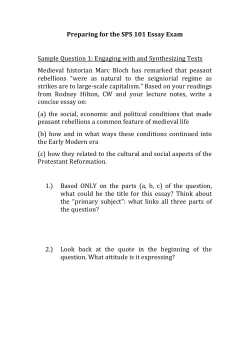
Application of StarCap 1500 as Filler/Binder/Disintegrant
Application of StarCap 1500® as Filler/Binder/Disintegrant in a Roller Compaction Dry Granulation Formulation Zahra N. Mahmoudi, Ngoc Do, Thomas P. Farrell and Ali R. Rajabi-Siahboomi Colorcon Inc., Global Headquarters, 275 Ruth Road, Harleysville, PA 19438 USA; www.colorcon.com/about/contact Results (cont’d) Supplier Composition (%w/w) Intragranular Ingredients Model API X - 22.20 Co-processed Pixture of Forn Vtarch/ Sregelatinized Vtarch [StarCap 1500] Colorcon 38.15 Microcrystalline cellulose NF [Microcel 102] Blanver 38.15 Mallinckrodt 0.50 Cabot 0.50 Mallinckrodt 0.50 Magnesium stearate NF [Hyqual] Extragranular Ingredients Colloidal silicon dioxide NF [Cab-O-Sil M-5P] Magnesium stearate NF [Hyqual] 100.0 In this formulation, no disintegrant or superdisintegrant was used, relying on StarCap 1500 disintegrant properties. Formulation Composition and Roller Compaction Compression, Film Coating and Physical Testing of Tablets The composition of the tablet formulation is shown in Table 1. The model API X was a white to off-white crystalline powder with a slight solubility of 3.5 mg/mL in water, poor flow properties (bulk/tapped densities: 0.39/0.62 g/cc; Carr’s compressibility index: 37%) and a volume mean particle diameter of 35μm. API, MCC and StarCap 1500 (1kg batch size) were blended for 10 minutes in a 4q V-blender (Patterson Kelly, USA). The intragranular magnesium stearate (MgSt) was screened through a 250-micron sieve (delumped), added to the mixture and blended for five minutes to make a pre-compaction blend. The above mixture was compacted on an Alexanderwerk-WP 120 roller compactor using 40 mm knurled surface rolls, set up at 40-bar pressure, feed screw speed of 40 rpm and roll speed of 7 rpm. The gap size was set at 2 mm, and the gap controller feature was used to produce uniform ribbons with consistent quality. The ribbons were milled using a Quadro Comil U-5 equipped with a 2 mm grater screen and operated at an impeller speed of 2500 rpm. Colloidal silicon dioxide and few grams of granules were delumped by passing them through a 30 mesh screen. The mixture was added to the granules and blended for five minutes. The extragranular MgSt was delumped as described for intragranular addition, added to the granules and blended for five minutes prior to compression. The loss on drying (LOD) of the blends was determined using a moisture analyzer (IR-200; Denver Instrument Company, USA). The blends were examined for particle size distribution using sieve analysis, powder flow using a vibratory funnel-type powder flowability tester (Sotax, USA), and bulk and tapped density. The latter values were used to calculate Carr’s compressibility indices. The formulation blend was compressed into 633 mg tablets on an instrumented (SMI) Piccola (Riva) 10-station, rotary tablet press set up with 15/32 inch SRC (11.91 mm) punch tooling and operated at 70 rpm. The ejection force, tablet thickness, weight variation and crushing strength of the tablets were measured on an Erweka Multicheck. The friability of 20 tablets at 100 drops was measured in a Vanderkamp friabilator. Tablet disintegration time (DT) was determined in deionized water according to the USP method (Erweka ZT-44; 4 station disintegration bath). Tablets were coated to a 3% weight gain in a Thomas 15” side-vented, fully-perforated coating pan with a pigmented, PVA-based Opadry II formula at a 20% solids concentration. The coating parameters are listed in Table 2. Table 2. Film Coating Parameters Process Parameter Inlet/exhaust air temperature (°C) Tablet bed temperature (°C) Air flow (m3/hr)/(ft3/min) Spray rate (g/min) Spray nozzle size (mm) Number of gun(s) Atomization air pressure (bar)/(psi) Pattern air pressure (bar)/(psi) Pan speed (rpm) Pan load (Active and Placebo Tablets; kg) The properties of the blend before and after the granulation, as well as tablet properties, are summarized in Table 3 and 4. The flow properties of the blend significantly improved from 2.3 g/sec to 8.18 g/sec upon granulation. The compressed tablets had satisfactory properties as shown in Table 4. Value 65/46 42 272/160 8 1 1 1.7/25 1.7/25 15 1 The content uniformity of the film coated tablets was evaluated (n=10) in accordance with the USP requirements. Tablet dissolutions were tested in 0.01N HCl using USP apparatus I (Basket), at 100 rpm. Both cores and coated tablets were packed into HDPE bottles and stored at 40°C/75%RH for stability studies. The dissolution profile and the potency assay of the tablets were tested initially, followed by testing after 3 and 6 months storage at the 40°C/75%RH storage condition. Figure 1. Comparative Dissolution Profiles of Uncoated and Coated RCDG Tablets (in 0.01N HCl) Figure 3. Dissolution Profiles of the Coated Tablets on Stability 100 Table 3. Blend Properties Test ID Total Methods Blend and Tablet Properties % Released(n=6) Methods Table 1. Formulation of a RCDG Tablet of a Micronized Model API X LOD (%) Bulk density (g/cc) Tapped density (g/cc) Carr’s compressibility index (%) Flow by Sotax (g/second) Geometric mean diameter (Njm) Geometric standard deviation Pre- Compaction Blend 5.2 0.39 0.57 32.6 2.3 83 1.80 Granulations 5.5 0.56 0.79 28.9 8.2 129 3.07 Uncoated Tablets 649.4 0.74 14.4/1.57 0.07 5.49 55 – 65 245.62 26.78 kN/240.5 MPa 40 20 5 10 15 Initial Stability Studies Table 5 shows that both coated and uncoated tablets had satisfactory stability after three and six months at 40°C/75%RH. Also, as indicated in Figures 2 and 3, the dissolution profile of the tablets remained unchanged upon six-month storage at accelerated conditions. In addition, the identical dissolution profiles of the coated and uncoated tablets resulted at the end of the stability studies, once more confirmed that the coating had no effect on the dissolution profile. Table 5. Potency Assay of Uncoated and Coated Tablets Average Potency Assay (%) Product Initial 40°C/75%RH 3 months 6 months Uncoated Tablets 103.3 100.3 105.9 Coated Tablets 102.6 101.1 107.8 20 25 30 Time (min) 3 Months 35 40 45 50 6 Months Conclusions • StarCap 1500 was successfully used in a 1:1 ratio with MCC in a roller compaction dry granulation tablet formulation of a poorly flowing, slightly soluble, micronized drug. The use of StarCap 1500/MCC combination in the tablets provided a short DT (<1 minute) without using any superdisintegrant in the formulation. Strong consistent tablets were produced with excellent accelerated stability when coated with an Opadry II (PVA-based) film coating system. References 1. Miller R.W.,” Roller Compaction Technology.” In Parikh D.M., Ed., Handbook of Pharmaceutical Granulation Technology (Marcel Dekker, Inc., New York, USA, 1997) pp99-150 Figure 2. Dissolution Profiles of the Uncoated Tablets on Stability Content Uniformity and Dissolution Profiles The average assay of 102.2% with a low RSD of 1.7% indicated that the tablets possessed a good content uniformity. Figure 1 shows a fast dissolution profile (>85% in 15 minutes) for cores and coated tablets indicating that the coating did not cause any significant change of the dissolution rate. 60 0 Table 4. Properties of Tablets (Press Speed: 70 rpm) Test ID Avg. weight (mg) (n=20) RSD% Crushing strength (kp) /Tensile strength (MPa) (n=10) Friability (%) Thickness (mm) (n=20) Disintegration time (second) (n=6) Ejection force (N) Avg. compression force/pressure 80 0 2. Herting M.G. and Kleinebudde P. Studies on the reduction of tensile strength of tablets after roll compaction/dry granulation. Eur. J. Pharm. & Biopharm. 2008; 70: 372-379. 100 % Released(n=6) Purpose Roller compaction dry granulation (RCDG) is widely used to improve poor flow properties of active pharmaceutical ingredients (API). However, work-hardening and reducing the re-workability of API and excipients are some of the disadvantages of this technique.1,2 In addition, high compaction force and recompression may reduce the drug dissolution rate, especially for poorly soluble drugs, which may then require a high level of superdisintegrant or utilizing more involved manufacturing processes such as wet granulation. Thus, for APIs having poor flow properties, relatively high loading and low water solubility, excipient selection plays a critical role in developing a dry granulation formulation, which will result in tablets with satisfactory mechanical strength and disintegration. In this study, the feasibility of using a combination of StarCap 1500®, co-processed starch excipient, and microcrystalline cellulose (MCC) in the development of a roller compaction formulation of a slightly soluble model drug was evaluated. 80 60 40 20 0 0 5 10 15 Initial 20 25 30 Time (min) 3 Months 35 40 6 Months 45 50 All trademarks, except where noted, are property of BPSI Holdings, LLC. The information contained in this document is proprietary to Colorcon and may not be used or disseminated inappropriately. ©BPSI Holdings LLC, 2010
© Copyright 2025












